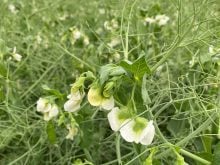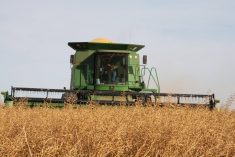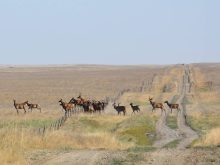NOW:
The Landrace breed, which was first registered more than 50 years ago, is one of the major breeds whose genetics help assemble the modern pig.
“Further up the chain, probably before the farm needs to worry about it, there will be herds of pure large whites (Yorkshire) and pure Landraces (which are crossed), which is making up that grandparent,” said Helen Thoday of the Prairie Swine Centre near Saskatoon.
When combined with the boar’s genetics, commercial pigs become a three-way cross.
And Canadian genetics are strong, said Thoday.
Read Also

Crop quality looks good this year across Prairies
Crop quality looks real good this year, with the exception of durum.
“Basically, since the 1950s, the drive for swine genetics was very much production-based and the advances in pigs to sow per year and the subsequent growth rates and conversion from feed to lean protein has been huge,” she said.
“And I think it’s fair to say we’ve reached an optimum for the current building systems that we have.”
Today, Canada’s purebred hog herds are managed by researchers, large multinational companies and 100 members of the Canadian Swine Breeders Association.
One organization, Genesus, registers 40 percent of purebred breeding stock in Canada, employs its own geneticists and exports pigs internationally.
Fast Genetics of Saskatchewan sent almost 900 pigs to China earlier this year.
Exports were rarer in earlier times, and purebred and cross gilts and boars would be sold regionally from the farm.
Most of the CSBA’s members are smaller family owned operations with 300 to 500 animals, said manager Nancy Weicker.
“They’re definitely in it for the genetics,” she said.
“They like to improve the breed. They are always performance testing and picking out the best of the litter.”
More than 97,000 purebred hogs were registered last year, with the largest numbers in Manitoba, al-though there are significant numbers in Ontario and smaller populations in Alberta, Saskatchewan, Prince Edward Island and Quebec. Most are of the three major breeds, but some producers are able to find niche markets for meat from heritage breeds, such as Berkshire, at farmers markets and high-end restaurants.
“I think that a lot of people of course want to know where their meat is coming from and want to buy locally,” said Weicker.
“I think that connection with the breeder to the consumer is important to the consumer, so the breeder sees that there is a market for him to have his own pork at the farmers market.”
Research into hogs genetics is steered by industry, including the large multinationals and the CSBA, under the banner of PigGen Canada. The organization identifies disease resistance, meat quality, longevity and animal welfare as priorities.
Thoday said the industry will eventually look for a more robust animal that can more easily recover from diseases such as porcine epidemic diarrhea. A move from gestation stalls to group housing in hog barns could also demand new genetics.
“Lameness and temperament are key because these animals are now interacting with each other, where before that hasn’t been an option in a stall system,” said Thoday.
Laurie Connor, a hog researcher with the University of Manitoba, is confident Canadian genetics can adapt to new housing.
“They perform very well in the group housing situation, but there are other aspects to the genetics, she said.
“And that comes down to not just disposition but things like feet and legs — structural soundness — which I think genetic companies are needing and probably are paying some more attention to. Going back to the basics, if you will, because certainly that will be very important as we move forward.”
THEN: Landrace pigs now registered in Canada
Official Canadian registration of the Landrace swine breed began in January of this year. The Canadian National Livestock Records Board now accepts American and British certificates to open the new herd book.
… Weanling sows sold at upwards of $300 each at Denfield, Ont., last fall in the only public auction of the Landrace held thus far in Canada.
THEN: Native-tame pasture combination boosts livestock carrying capacity
Twice as many cattle can be run on a combination of native and tame pastures as upon the same acreage of only native grasses.
That was the contention of Dr. D.H. Heinrichs of the Swift Current, Sask., experimental farm recently. Dr. Heinrichs, who heads the station’s forage crops section, declared that legumes in a hay or pasture mixture enormously boost output over the years. He predicted that alfalfa will become the most important single forage crop on the plains area.
In the Feb. 20 issue:
Then & Now:
Victory Bonds played a vital role in raising funds for Canada’s war efforts.
See the rest of this series online at www.producer.com.














